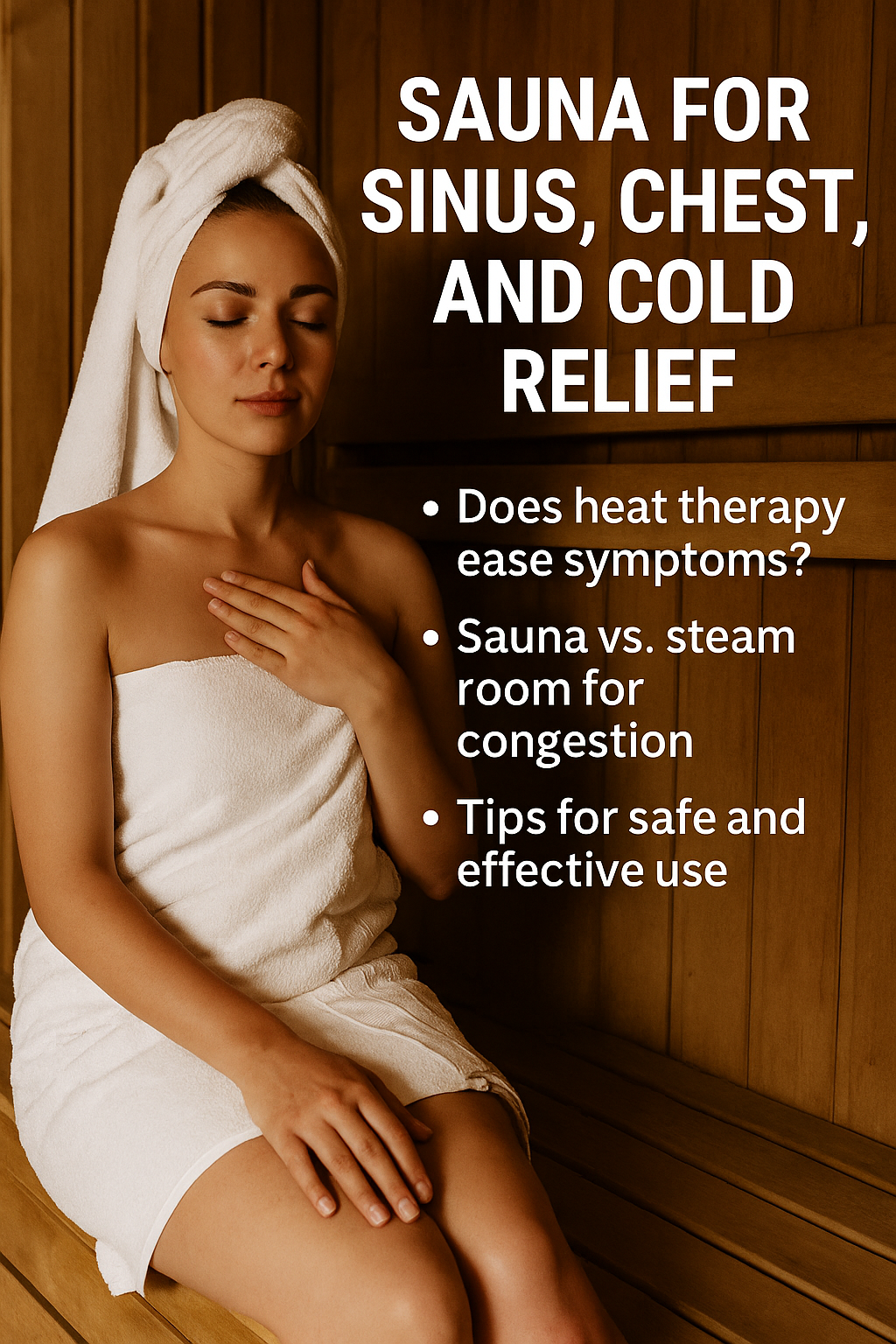Introduction: Steam, Heat & Healing
TL;DR: Saunas—especially steam and infrared types—can provide short-term relief for sinus congestion, colds, and mild chest tightness. They help open airways, loosen mucus, improve circulation, and ease inflammation. However, saunas donot cure infections and should be used with caution if fever or dehydration is present.
A steamy sauna session is often touted as nature’s remedy for the sniffles or stuffy nose. But how effective is it, really? Can sitting in a sauna help with a cold, sinus pressure, or chest congestion? This blog dives into the science, best practices, and safety tips behind using heat therapy to manage cold-related symptoms.
Table of Contents
-
How Saunas Work to Relieve Cold Symptoms
-
Steam Room vs. Dry Sauna for Sinus Relief
-
Can Saunas Help with Chest Congestion?
-
Saunas for Sinus Infections: What You Need to Know
-
Can a Sauna Help with a Cold or Make It Worse?
-
Best Time to Use the Sauna When You’re Sick
-
Safety Guidelines: When to Avoid the Sauna
-
Sauna Tips for Respiratory Relief
-
Scientific Evidence: What Studies Show
-
Frequently Asked Questions
-
Final Thoughts
1. How Saunas Work to Relieve Cold Symptoms
Saunas alleviate cold symptoms by triggering a cascade of physiological effects. The rise in core body temperature inducesthermoregulation, where the body tries to cool itself by dilating blood vessels—a process known asvasodilation. This increases circulation and helps deliver more oxygen-rich blood to congested or inflamed areas, including the sinus and respiratory passages.
The heat also promotesmucociliary clearance, loosening mucus from the airways and sinuses so it can be more easily expelled. Steam saunas further hydrate the nasal lining, reducing irritation caused by dry air.
On a systemic level, saunas can stimulate theimmune response by mimicking a fever-like condition. This mild hyperthermia may boost white blood cell production and increase the activity of heat shock proteins, which play a role in pathogen defense and cellular repair.
These combined effects offer symptom relief from congestion, sinus pressure, and chest tightness—though they should not be confused with a cure.
Keywords Answered: does sitting in sauna help with a cold, is a sauna good for a cold Heat from saunas increases core temperature, promotes sweating, and improves circulation. This can:
-
Loosen mucus in nasal passages
-
Open airways through heat-induced vasodilation
-
Enhance blood flow to affected areas
-
Temporarilysoothe inflammation in sinus and chest tissues
This makes saunas a natural remedy for temporary symptom relief—not a cure.
Keywords Answered: does sitting in sauna help with a cold, is a sauna good for a cold
2. Steam Room vs. Dry Sauna for Sinus Relief
Steam rooms are often more effective for upper respiratory congestion due to high humidity levels. Moist heat directly hydrates dry mucous membranes and helps thin out mucus.
Dry saunas offer overall warmth and relaxation but may dry out nasal passages in some users.
Comparison Table
| Type | Benefit | Drawback |
|---|---|---|
| Steam Room | Loosens mucus, hydrates sinuses | Can feel too hot/humid for some |
| Dry Sauna | Relaxes muscles, boosts circulation | May dry nasal passages |
| Infrared | Penetrates deeper, gentle on body | Less steamy; subtle effect |
Keywords Answered: sauna or steam room for sinus infection
3. Can Saunas Help with Chest Congestion?
Yes. The heat from both steam and dry saunas can:
-
Loosen phlegm in lungs and bronchi
-
Encourage productive coughing
-
Relax chest muscles
This can ease breathing, reduce wheezing, and support your immune system’s effort to clear infection.
It’s important to distinguish betweenproductive anddry coughs:
-
Aproductive cough brings up mucus and may benefit significantly from sauna sessions that promote mucus drainage and expulsion.
-
Adry cough, often caused by irritation or post-viral inflammation, may temporarily worsen in dry saunas due to air dryness. Steam rooms are usually more helpful in this case, as moist heat soothes irritated airways.
For chest tightness or wheezing from a cold, combining a short steam room session with deep breathing can provide noticeable relief. However, always monitor symptoms and stop if breathing becomes difficult.
Keywords Answered: is sauna good for chest congestion, is a sauna good for chest congestion? Yes. The heat from both steam and dry saunas can:
-
Loosen phlegm in lungs and bronchi
-
Encourage productive coughing
-
Relax chest muscles
This can ease breathing, reduce wheezing, and support your immune system’s effort to clear infection.
Keywords Answered: is sauna good for chest congestion, is a sauna good for chest congestion
4. Saunas for Sinus Infections: What You Need to Know
Mild sinus infections caused by colds or allergens may benefit from sauna use through:
-
Improved drainage of sinus cavities
-
Reduced pressure and swelling
-
Relaxation that may reduce sinus-triggered headaches
However, if your infection isbacterial or includes a fever, sauna use should be avoided. Increased body temperature can worsen symptoms and slow healing.
Keywords Answered: is a sauna good for a sinus infection
5. Can a Sauna Help with a Cold or Make It Worse?
Used correctly, a sauna can offer:
-
Symptom relief for nasal congestion and muscle aches
-
Mental relaxation, which supports recovery
-
Improved sleep, especially with nighttime colds
However, there are specific conditions where sauna use mayworsen symptoms or create health risks:
-
Fever: If your body temperature is already elevated, sauna use can dangerously raise it further, increasing the risk of heat exhaustion or heat stroke.
-
Dehydration: If you’re already dehydrated due to illness symptoms like vomiting, diarrhea, or sweating, using a sauna may compound the issue.
-
Severe fatigue or weakness: Heat stress can place additional strain on your cardiovascular system, making recovery more difficult.
-
Respiratory infections: If you have a bacterial chest infection, the hot and dry air may irritate inflamed lung tissues, potentially making symptoms like coughing worse.
-
Use of medications: Some medications (e.g., antihistamines or decongestants) may alter how your body handles heat, increasing your susceptibility to overheating.
When in doubt, consult your physician—especially if your symptoms are severe, persistent, or you're taking medications that could interact poorly with heat exposure.
Keywords Answered: can sitting in a sauna help with a cold, will a sauna help a cold, does a sauna help a cold? Used correctly, a sauna can offer:
-
Symptom relief for nasal congestion and muscle aches
-
Mental relaxation, which supports recovery
-
Improved sleep, especially with nighttime colds
However, risks include:
-
Overheating if you have a fever
-
Dehydration, especially with diarrhea or vomiting
-
Fatigue, if your body is already weak from illness
When in doubt, consult your physician.
Keywords Answered: can sitting in a sauna help with a cold, will a sauna help a cold, does a sauna help a cold
6. Best Time to Use the Sauna When You’re Sick
Use a sauna when:
-
You're in theearly or recovery phase of a cold
-
You feelcongested but not feverish
-
You need relief fromheadaches, muscle soreness, or sleep trouble
Avoid saunas during peak illness or with flu-like symptoms.
7. Safety Guidelines: When to Avoid the Sauna
Avoid saunas if you have:
-
Fever over 100.4°F (38°C)
-
Fatigue, chills, or severe cough
-
Dehydration symptoms
-
Ongoing antibiotics (unless cleared by a doctor)
Pregnant individuals or people with heart or lung conditions should consult a medical professional before using a sauna for cold relief.
8. Sauna Tips for Respiratory Relief
Here’s a practical checklist to maximize the respiratory benefits of sauna use when sick:
-
✅Use essential oils (eucalyptus, menthol): Add to steam rooms to open nasal passages and improve breathing.
-
💧Stay hydrated: Drink electrolyte-enhanced water before and after your sauna session to avoid dehydration.
-
⏱️Limit time to 15–20 minutes: Especially when recovering from illness, shorter sessions are safer and more effective.
-
🌡️Choose infrared for gentle recovery: Infrared saunas provide deep tissue warmth with lower ambient heat, ideal during the recovery phase.
-
🚫Skip the cold plunge: After a sauna session during sickness, avoid sudden cold exposure that may stress the immune system.
-
🪑Sit upright and breathe deeply: Position yourself comfortably to allow full lung expansion and maximize airway clearance.
-
🕒Use during early or recovery phases: Avoid sauna use during peak symptoms like fever or body chills.
By following these tips, you can enhance symptom relief while minimizing risks during sauna use for sinus, chest, or cold discomfort.
-
Useeucalyptus or menthol oils in a steam room to open airways
-
Drinkelectrolyte-enhanced water before and after
-
Limit sessions to15–20 minutes when sick
-
Tryinfrared sauna during recovery for gentle heat
-
Avoid cold plunge immediately after if your immune system is compromised
9. Scientific Evidence: What Studies Show
Several studies have examined the role of sauna therapy in respiratory and immune health, offering promising—though not definitive—support for its use in symptom relief and illness prevention.
-
A 1989 German study published inAnnals of Medicine reported that individuals who used a sauna regularly over six months experienced a30% reduction in the incidence of common colds, suggesting improved immune resilience.
-
Research published inComplementary Therapies in Medicine (2010) linkedinfrared sauna sessions to enhanced production of white blood cells andreduced inflammation, both key components of immune defense.
-
A 2017 review inEvidence-Based Complementary and Alternative Medicine highlighted howheat exposure boosts immune system efficiency, including improved activity of heat shock proteins and a temporary increase in core body temperature that mimics the effects of a fever, potentially aiding viral suppression.
Mechanistically, saunas may support immune function by:
-
Stimulating circulation, enhancing the delivery of oxygen and immune cells
-
Promoting lymphatic drainage, which aids in clearing toxins
-
Increasing leukocyte (white blood cell) activity, helping your body combat infections
-
Reducing cortisol levels, which may indirectly benefit immune response and recovery
While more large-scale, placebo-controlled studies are necessary, current evidence indicates that regular sauna use can play a supportive role in respiratory health and cold management when paired with proper medical care.
-
A 1989 German study published inAnnals of Medicine showed thatregular sauna use reduced incidence of the common cold by 30%.
-
Research inComplementary Therapies in Medicine (2010) linkedinfrared sauna sessions to improved immune markers and reduced respiratory discomfort.
-
A 2017 review inEvidence-Based Complementary and Alternative Medicine found thatheat exposure enhances immune cell response and may improve recovery times.
While more studies are needed, evidence supports saunas as a complementary therapy.
10. Frequently Asked Questions
Q: Will the sauna break up mucus?
A: Yes, especially in a steam room. Moist heat thins mucus and helps drain sinuses.
Q: Should I use the sauna if I have a sore throat?
A: Possibly—if it’s mild and you’re not feverish. The heat can soothe muscles but may irritate if dryness is present.
Q: What’s the best sauna for colds?
A: Steam rooms for nasal congestion; infrared for body aches and immune support.
Q: Can I use essential oils in a sauna?
A: Yes—especially eucalyptus or peppermint in a steam setting. Avoid adding oils to dry or infrared saunas directly.
11. Final Thoughts
A sauna can be a soothing companion during cold or allergy season—helping you breathe easier, rest better, and support recovery. It’s not a substitute for medical treatment, but when used wisely, it’s a powerful tool in your cold relief toolkit.


